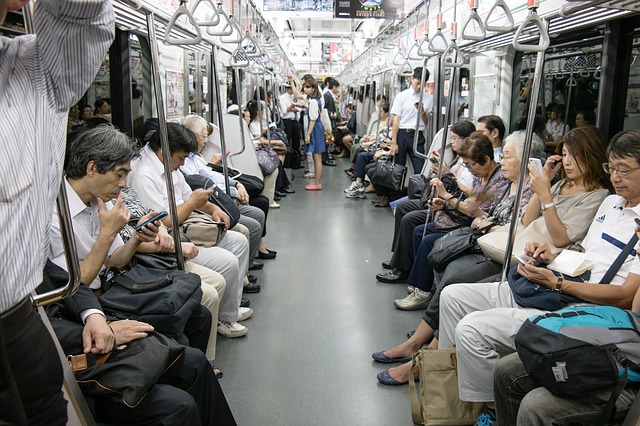Journeys Below Ground
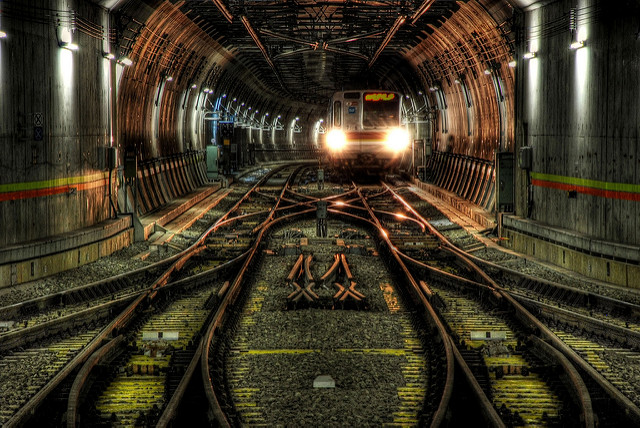
A Fukutoshin Line Metro train approaching Shibuya Station – the point at which the subway officially ends and the train continues onto a regular ‘overground’ commuter line.
No guide to subterranean Japan can be complete without including the enormous tangle of tunnels that make up Tokyo’s immense underground railway. There are rival claims to be the world’s biggest, but they rely on counting each of Tokyo’s many subway operators separately, or on counting the overground parts of their systems – while not doing the same for Tokyo. By any fair count, Tokyo has by far the biggest and the busiest subway in the world.
Tokyo eats, lives and breathes train, and besides walking and bike, rail is really the only way to get around. Buses play a bit-part role at the periphery of the system, and while many families own cars, they usually stay parked from Monday to Friday – as much a status symbol as a practical form of conveyance – at least until you get well into the fringes of the megalopolis.
The earth under Tokyo is chock full of so many tunnels, stations, connecting passageways, and who knows what else, that it’s a miracle it all fits. Someone a lot cleverer than me must have put this giant jigsaw together. Some stations include whole subterranean shopping malls, and are so big you can walk for miles. In places it’s possible to get from one station to another on foot without needing to venture up to street level. Passageways take strange twists and turns, ups and downs, sometimes avoiding other tunnels only by centimeters. A train could be zooming past on the other side of a wall, while another skims over your head unseen.
So, what is the Tokyo underground? That’s a tricky question, as absolutely heaps of companies operate everything from giant bullet trains to tiny trams – just what counts? Well, there are two main subway companies: Tokyo Metro operates 9 lines, 179 stations and carries 6.8 million people every day. But there’s also the Toei Subway with its 4 lines, 106 stations and 2.9 million daily passengers. Those two are what most people count as the Tokyo underground, but the Rinkai Line runs entirely underground (and undersea) in the Tokyo Bay area – so I’m counting it too.
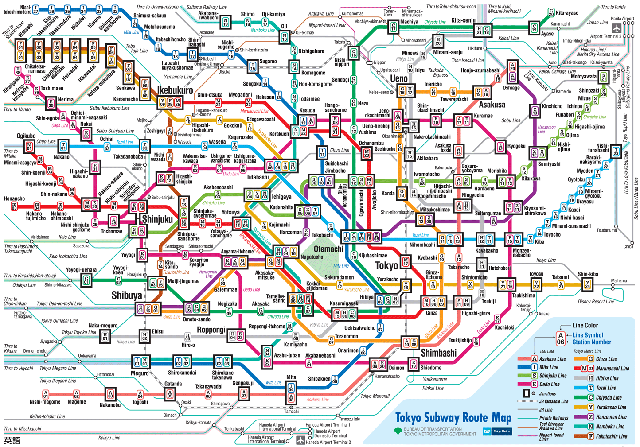
This is the most common official subway map, showing both the Tokyo Metro and the Toei Subway. (Click to enlarge.) The darker lines are the parts of the network owned and run by Toei and Tokyo Metro. Where trains continue onto other companies tracks, this is shown with lighter colours. Lines which don’t have through running with the subway are shown with narrow lines or in grey. Most stations that aren’t part of the subway proper aren’t shown at all.
Now lets get really confused: The Odakyu Line is a commuter line running for 83km, from Shinjuku Station in central Tokyo out to Odawara, a town close to Fuji-Hakone-Izu National Park. It has branches leading to the beach (at Enoshima) and another leading to Karakida in the western suburbs. While it does run underground for part of its route, this is clearly not a subway line. Or is it? The complication is that it’s been joined on to the Metro’s Chiyoda Line, a regular subway line running from the northeast to the southwest of the city. This allows some of Odakyu’s trains to run on to the Metro line, instead of continuing to their usual terminus at Shinjuku, and for Metro trains to run to Odawara and Karakida. So, if we’ve got subway trains running on this line, shouldn’t we count it as part of the subway? I think so, at least when we’re making comparisons with other cities, most of which have large parts of their ‘subway’ systems above ground. If we count the parts of the Odakyu Line traversed by subway trains, the Tokyo underground suddenly becomes 79km longer.
But that’s not all. To improve access to the Hakone resort area (famous for its hot springs and views of Mount Fuji), Odakyu have started running their ‘Romance Car’ trains on the Chiyoda Metro Line. Romance Cars are luxury leisure trains, with plush carpets and elegant interiors. You need to pay a supplement and reserve a seat to travel on them, but some of them stop at four of the Chiyoda Metro Line’s stations. Even better, rather than stopping at the end of the Odakyu Line, they continue on to the Hakone Tozan Line, delivering you directly to the resort town of Hakone Yumoto. This isn’t exactly a typical commuter service, but it does operate on a subway line that runs right through central Tokyo, so I think it deserves to count. So we’ll have to add another 17km to the length of the underground.
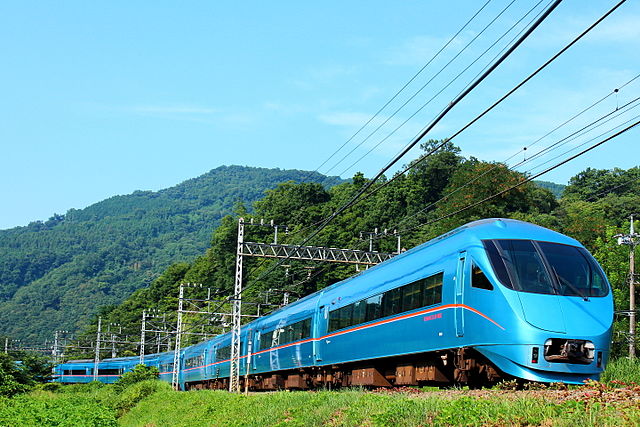
This might not look much like a city subway to you, but this train started its journey on the Chiyoda Metro Line. Passengers must have a reservation, but are able to board at one of four stations on the Chiyoda Line at which it stops. This must be one of the most convenient ways to start a holiday – just go straight from your office and you can arrive in the mountains less than two hours later.
Now, the Chiyoda Line is a bit of a special case – no other subway line has deluxe reserved-seat trains – but the practice of connecting subway lines up to surface lines is very common, and in most cases there is a through service every few minutes. Four subway lines are connected to surface lines at one end, while seven are connected at both ends. For example, the Fukutoshin Line runs for 20km down the west side of Tokyo, connecting the world’s two busiest stations (Shinjuku and Ikebukuro) in the process. But the southern end of the line as been joined up to Tokyu Railway’s Toyoko Line allowing trains to run through to Yokohama Station, where the Toyoko Line in turn has been joined up to the Minatomirai Line (which itself is entirely underground), allowing subway trains to reach all the way to the terminus at Motomachi-Chukagai. If we count these two lines, that adds another 28km to the size of the Tokyo underground.
Now let’s look at the other end of the Fukutoshin Line. This is connected to the Tobu Tojo Line providing through services to Shinrinkoen Station, and a branch before the end connects to the Seibu-Yurakucho Line and on to the Seibu-Ikebukuro Line, allowing through service as far as Han-No Station. And yes, there are trains that travel these entire routes – it takes 110 minutes to cover the 88.6km from Shinrinkoen to Motomachi-Chukagai, and 95 minutes for the 80.5km trip there from Han-No. If we add on these extensions, the Tokyo underground grows by another 80.4km.
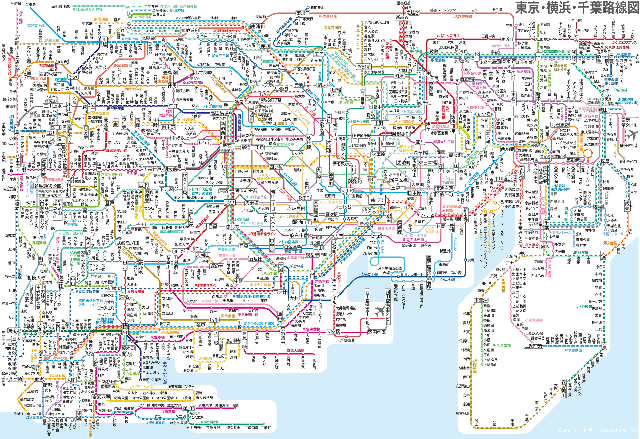
You won’t see a map like this around Tokyo very often – and you can probably guess why. (Click to enlarge.) It shows every train line and station, and covers most of the greater Tokyo area, although some trains from the subway run beyond the edges of this map, including Odakyu’s Romance Cars.
You’re may be starting to see why no one has a single figure for the size of Tokyo’s underground – but you’re probably getting the idea that it’s big. Very big. And this isn’t even counting the numerous surface lines that don’t have through-services with the subway, some of which run with frequencies of as much as 30 trains an hour at peak times. And then we could start adding elevated lines, monorails, rubber tired automatic people-movers, trams and bullet trains – all of which play a role in Tokyo’s mammoth daily commute. Hopefully I’ve done enough to convince you that Tokyo’s subway really is the biggest, though I expect aficionados of other cities will continue to argue their case. Take a look here to see some of the competing claims.
Seikan Tunnel